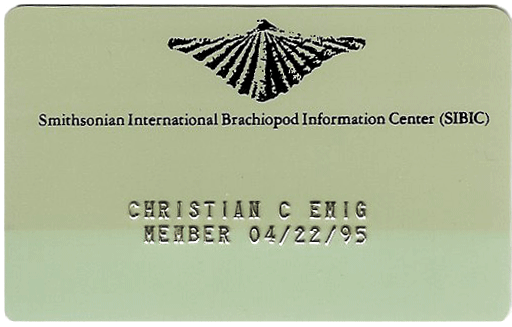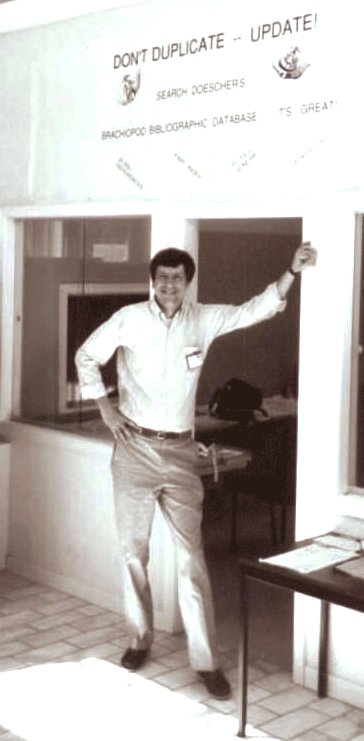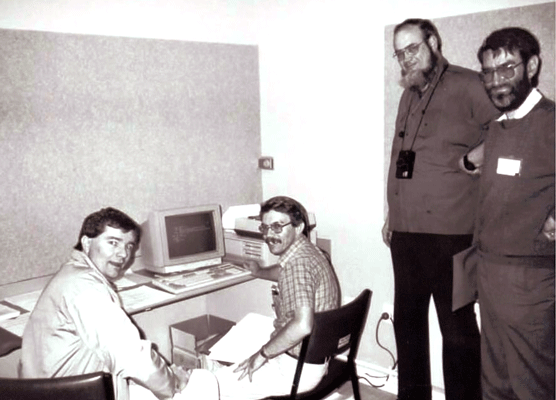  |
|
Home
Database
» Linguliformea
» Craniiformea
» Rhynchonelliformea
List of species and genera
Number of taxa
References
S.I.B.I.C. >
Photo album
Links About Us Contact Us |
Smithsonian International Brachiopod Information Center
S.I.B.I.C. (1990 - 1996) The SIBIC database prepared by Rex Doescher is no longer available on the Web site http://www.nmnh.si.edu/. The original copy stored here in Brach-database:
[*]Alphabetic list with format GOPHER - Created 9 Feb 1996, at 13:06 by Rex Doescher - more than 2,000 pages. [**] Doescher R. 1982. "Living and Fossil Brachiopod Genera 1775-1979, Lists and Bibliography". Smithsonian Contributions of Paleobioogy, 42, 1-238 (1982). The SIBIC When I joined the Dept. of Paleobiology (National Museum of Natural History, Smithsonian Institution) in 1973 [***], I was greeted shortly thereafter by Mrs. G.A. Cooper, who expressed her desire that I maintain her bibliographic file which she updated for years on 3x5 cards (bibliographic info. & generic information). It truly was a monumental job on her part and, I, as a fledging new assistant to Richard Grant, was not that excited about! There must have been over 10,000 cards in the file and along with the generic file (which dealt with the first reference to every new brachiopod genus to that time), a treasure of information was awaiting someone to computerize this, so the brachiopodologists could access it. Mrs. Cooper even translated the Russian papers, which dealt with new genera. Not until some years later did I really comprehend the magnitude of the data but did keep the files current. At the time I joined the Smithsonian, the computer was in it's infancy (main frames and punch cards were the item of the day and you had to wait days to correct the inputted data). There was no mechanism for bibliographic software and I had programmers create the rudimentary programs, which inputted and sorted my data. Not until the late 80's did I stumble upon Papyrus (a PC software) and which became the perfect program for the bibliographic data. As I mentioned early, it took a great deal of time to enter and clean up the bibliographic information but when it was completed, probably in the late 80's, I realized that it might be a mechanism whereby I could get some money for computer accessories, i.e., a laptop and backup devices. As an assistant to a curator, there was no individual monies, so, in consultation which Dick Grant, we made up the name SIBIC. This actually made sense, since the Smithsonian was created as an instrument to "increase & diffuse knowledge". I thought that US$50/brachiopodologist/year was not exorbitant, and with it, they would get a membership card (see example below). I also took a spirifer from the Cooper & Grant's West Texas Monograph as representative of the phylum. However, when the monies started coming in, with checks made out to SIBIC, it caused some consternation with the Smithsonian money managers. Finally, I was able to access the money from a special Fund and life was beautiful! It was only the fact that Cooper had finally "retired and left the Museum", and Dick had a sudden heart attack and passed (my mentors), that I considered leaving early. Life at the Smithsonian was not the same, as under Secretary Ripley, when science and discovery were paramount! I was given such freedom by Dick to pursue my goals, that now, looking back, I consider myself a lucky man! I got to know "Coop" and shared his love of photography. I also developed many friends in the Phylum which I treasure and was able to attend Brachiopod Congresses and accompany Dick to Greece which was also memorable. [***] I often think back on my good fortune to be at the right place and at the right time for a challenging gov't career...this opportunity for a guy who had trouble getting his B.A. degree in Geology and was told by his paleo. teacher that there were no opportunities for paleontologists without a Ph.D. degree! online since September 16, 2007. Nota: Earlier, from 1983 to 1986, Rex Doescher edited the "Armfoot" Newsletter, one # each year and a special edition in 1985 on the 1st Congress in Brest: download in pdf (9.3 MB)  SIBIC... at the 2nd Brachiopod Congress in Dunedi (New Zealand, 1990) |
|
|


